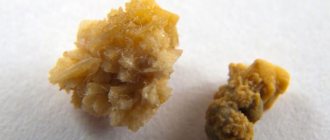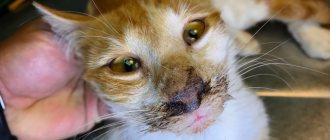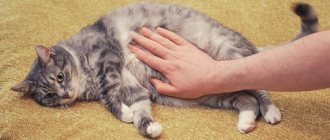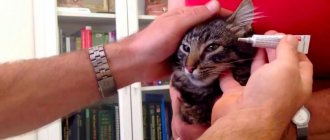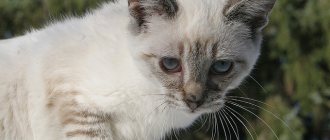What are urinary tract stones in cats?
Urinary tract stones in cats are diseases caused by the deposition of sand and stones in the urinary tract. Our pets' urine contains many minerals. They are usually dissolved in it, but under favorable conditions they can precipitate, forming the aforementioned sand or stones.
Cats have three types of urinary stones, which differ in the minerals they contain. The most common are magnesium ammonium phosphate stones, commonly called struvite. The second type is gout. In addition, cats can also form calcium oxalate stones.
Cystine uroliths
Cystine uroliths are formed in cats with cystinuria, which occurs as a congenital disorder of the reabsorption of cystine and other amino acids (ornithine, lysine, arginine) in the proximal tubules of the kidneys. In most cases, cystine uroliths are found in aging cats.
Small cystine uroliths can be removed from the urinary tract by flushing it with high pressure water. Large urinary stones must be removed surgically (through cystotomy).
Electron microscopy image of cystine urolith
Reduce the content of methionine and cystine in the diet while using drugs containing thiol.
Alkalinization of urine. The solubility of cystine depends on the pH environment; it increases in alkaline urine. You can increase the pH of urine by using a diet containing potassium citrate or by giving animals this drug orally.
Types of urolithiasis in cats
One of the criteria for the spread of urolithiasis, which can occur in cats, is their type: therefore, renal ammonium magnesium phosphate, urate and calcium oxalate are distinguished. The location of loss of mineral crystals also matters: kidney stones, urolithiasis (urethral and bladder stones).
Chronic kidney disease is a progressive disease, and many cats may develop some degree of it as they age as a result of the gradual deterioration of the functional parts of the kidneys. Treatment usually consists of fluids, a special diet, and medications to help slow the progression of the disease and help your cat feel better.
Treatment
Urolithiasis is a severe and very serious disease that requires an integrated approach to treatment. To eliminate painful symptoms, conservative methods and surgical intervention are used. There are also medications that can alleviate the animal’s condition.
Treatment at home
Correct and timely diagnosis contributes to quality treatment. You can cure a cat yourself, but this should be done under the supervision of a doctor.
If there is no urine output, you should not give your pet diuretics to avoid pain. To relieve spasms, you can give several No-shpa tablets. Pre-medical assistance is exhausted by these actions. The cat should be treated by a specialist, depending on the stage, development and main symptoms of the disease.
Symptoms of the disease
Drugs
If a disease of the genitourinary system is detected on time and the pet’s condition is not serious, then simple treatment will come to the rescue. Medicines are used as part of the diet.
If the course of the disease is complicated by infectious symptoms, the veterinarian will prescribe antibiotics. Most often, Lincomycin is prescribed, as well as antimicrobial medications of the cephalosporin group (Tseparin, Kefzol).
It is also important to use uroseptic antibacterial drugs that specifically affect the genitourinary system. Animals are prescribed 5-NOK, Furagin or Palin.
For dehydration, use Regidron. The drug is administered into the pet's mouth in small portions.
Cantaren is a homeopathic remedy for injection. The medication relieves inflammation, spasms, and has a diuretic effect. The medicine is administered subcutaneously or intramuscularly.
Surgery
In advanced cases, surgical intervention is necessary. You cannot do without it if the obstruction recurs, as well as if it is impossible to remove the plug conservatively.
The operation is necessary in the following cases:
- urethral blockage;
- very large stones are not released after washing;
- insoluble oxalate stones.
There are 2 types of surgical method:
- Urethrostomy. The essence of the method is that a hole is made in the urethra through which uroliths come out.
- Cystotomy. A radical method used in especially serious cases. The surgeon cuts the bladder and then removes the stones.
After surgical treatment, the cat needs a long recovery, as well as a lifelong diet.
Furagin
Symptoms of urinary tract stones in cats
Clinical symptoms include difficulty or frequent urination, blood in the urine. Cats urinate incorrectly and in different places. Kidney stones can cause abdominal pain, especially in the lower back (rare). If stones lodge in the urethra, they can make urination difficult or completely difficult. Kidney stones are located in the renal pelvis and can cause obstruction or pyelonephritis.
You should also pay attention to excessive urination: the cat will produce dilute and large amounts of urine. This will force him to drink more water to replenish lost fluids.
Poor appetite and lethargy are signs that toxins normally excreted in urine are building up in the body. It can also lead to vomiting and bad breath.
Cat nutrition for urolithiasis
Only if a proper diet is maintained, a cat with urolithiasis can live painlessly for several years. Some animals eat exclusively dry food, while others eat homemade food. Accordingly, approaches to diet may vary.
Dry food for urolithiasis
The vast majority of dry food in stores is unsuitable for feeding cats with urolithiasis, as they contain a lot of mineral salts. There are special foods selected taking into account the type of stones:
- for struvite Hill's Prescription Diet C/D or Purina Pro Plan Veterinary Diets UR;
- for oxalates Hill's PD Feline K/D or Royal Canin Urinary S/O LP34.
You should not save, but you need to buy premium or super-premium products.
Homemade food
Increased acidity of urine is caused by high calcium levels, so you need to remove milk and eggs from your diet. Calcium is also present in some vegetables - these should also be limited. When dealing with oxalates, it is not recommended to feed animals by-products that contain a lot of oxalic acid.
A monotonous diet should also be avoided. The menu should include meat dishes, but industrial feed should not be added to the diet. The animal requires unlimited access to water.
Published in Diseases
Diagnosis of urolithiasis in cats
Stones are found during tests for other diseases, but symptoms such as hematuria, abdominal pain, or recurring urinary tract infections may indicate urolithiasis. It should be remembered that urolithiasis in both kidneys can lead to irreversible damage or failure. Some stones can be diagnosed using x-rays, but the preferred testing method is ultrasound (ultrasound). Sometimes it is necessary to conduct an examination using urography (x-ray contrast study). The contrast agents used for this test may be toxic to the kidneys.
Diagnostic features
The only way to diagnose ICD is by microscopy of urine sediment. This procedure is included in her overall clinical analysis. Often the disease is chronic and periodically worsens. Owners have to buy special powders like litmus paper from pet stores, which are added to the tray filler. If the color of the powder changes, there is a high likelihood of an exacerbation and a blood test is needed.
When visiting a veterinary clinic in Moscow with symptoms of ICD, an animal may require the following tests:
- Clinical examination, including palpation of the abdomen to help determine bladder fullness.
- Clinical analysis of urine, determining the presence/absence of crystals in it, as well as their type. If large and dense stones have already formed, the result will be negative.
- Ultrasound to assess the condition of the bladder walls. The content of suspended matter in an organ is almost always detected using this test.
- X-ray of the abdomen to examine stones not detected by ultrasound. The study is carried out when there is no ultrasound machine or there are indirect signs of stone formation.
- If stones are not detected, the doctor may resort to x-ray examination using a contrast agent - this diagnostic method is quite accurate and effective.
- To determine whether there is damage to the kidneys, the specialist also orders biochemical and general blood tests.
What are the causes of urolithiasis in cats?
Cats may have a genetic predisposition to urolithiasis, or at least certain types. The inappropriate pH of cat urine also contributes to stone deposition. Of course, behavioral risk is associated with the pet’s diet.
Phosphate-ammonium-magnesium stones (struvite) precipitate in an alkaline environment. This urine pH is maintained by a diet consisting primarily of dry cat food, rich in minerals and energy compounds, with a small amount of water consumed by the fluffy cat. In cats, struvite is the main cause of urethral obstruction.
The acidic pH of cat urine and a diet rich in beef and liver promote the formation of gout stones. These types of stones are found primarily in the bladder of cats.
Quite often, our pets are found to have calcium oxalate stones, which primarily cause diseases of the lower urinary tract. They are favored by an acidic environment and too long feeding with urine acidifying products used in the treatment of struvite. Calcium oxalate stones are thought to occur in cats of all ages, but are most common in Persians and Burmese.
Urinary cylinders
Precipitates without a specific structure. They are formed from exfoliated tissue elements, blood and inflammatory cells, and a large amount of matrix substance. Crystalline components are not always present in urinary cylinders. If they are found in mineral components, they are often formed by struvite. Uroliths and casts are physically different and occur for different reasons and are more often found in males than females. The urethra is narrower in cats and urinary cylinders can cause partial or complete obstruction. Idiopathic cystitis is one of the factors contributing to the formation of urinary casts.
In case of obstruction of the urinary tract by urinary cylinders, it is necessary to eliminate the obstruction of the urinary tract and restore urine flow, restore the acid-base balance of the body, the balance of fluids and electrolytes.
Prevention of urolithiasis in cats
As always, prevention is better than cure. The veterinary pharmacy and pet store Homeovet offers special foods and vitamins that are used to prevent the formation of stones in the urinary tract in cats. Preventing urinary tract stones in cats primarily involves eating a varied diet and ensuring your pet is consuming the right amount of fluids.
Reasons for the development of the disease
Urolithiasis in cats develops for many reasons, which can be divided into two large groups - endogenous and exogenous. Most often, the disease is provoked by external factors, so the pet owner is usually to blame.
External factors
This group of reasons for the development of ICD includes:
- Wrong diet. Unsuitable food or lack of drinking water are common problems. The use of ready-made cheap feed and the animal’s lack of access to water are unacceptable. Many people don’t even realize that boxes of cat food on store shelves cause urolithiasis. Due to lack of water, urine becomes more concentrated, its pH changes and urinary stones begin to form.
- Poor quality water and climate. In hot climates, urination increases, and lack of water or lack of access to it creates the same effect as described above. Poor-quality tap water with large amounts of heavy metal salts and other impurities is harmful to cats.
- Avitaminosis. A deficiency of vitamin A, essential for healthy skin and mucous membranes, causes great harm. Against the background of hypovitaminosis, the condition of the urethral mucous membranes deteriorates.
Internal factors
There are several internal causes leading to urolithiasis, namely:
- Hormonal imbalances. Lead to disruption of material metabolism and the formation of stones. In normal conditions, the urethra in cats is narrow and long, and each deformation or pathology creates conditions for the development of urolithiasis. Almost any malfunction in the gastrointestinal tract and a violation of the acid-base environment in the urine are provoking factors.
- Cystitis, obesity, lack of mobility - all these factors are also dangerous to the health of cats. A typical patient in veterinary clinics are cats under 5 years of age, fluffy and overweight, who do not go outside and are constantly half asleep, and also eat inexpensive dry ready-made food.
- Heredity. There are pets that are predisposed to the disease, and all other factors only increase the likelihood of developing urolithiasis.
Diagnosis
Inflammatory diseases of the bladder are very common in cats, and the clinical signs for them are approximately the same as for stones. Therefore, all the clinical signs described above are not a reason to diagnose “urolithiasis”. In quite rare cases, uroliths can be detected with the help of banal palpation , but only when their size is above average. Many cats with urolithiasis have only a few small stones in the bladder cavity, which, even if they try, cannot be detected by palpation. More modern diagnostic methods are needed.
Most bladder stones are clearly visible on x-rays or ultrasound examination of the organ. It is believed that these diagnostic methods should be tested in cases where a cat has hematuria and dysuria: both of these symptoms are fraught with the development of deadly intoxications , so the cause of what is happening to the animal must be clarified urgently.
Some bladder stones, however, cannot be x-rayed, since they can be formed from mineral compounds through which the rays of an x-ray machine pass freely. To identify them, one should resort to either ultrasound or perform “contrast radiography”. In the latter case, the bladder cavity (using a urethral catheter) is filled with a special contrast solution, “against the background” of which the uroliths become clearly visible.
If the calcium level in the blood is normal, the following regimen is recommended:
- Feed non-acidifying feeds to minimize the risk of calcium oxalate in the urine. Such diets contain a normal dose of calcium, a moderate amount of magnesium, and potassium citrate is added to bind calcium in the urine. Monge Urinary Oxalate is considered a suitable product. In some cases, your doctor may prescribe Hill's c/d, Hill's w/d (a diet for diabetes mellitus recommended to relieve the underlying problem), Royal Canin s/o, Iams eukanuba Moderate pH/O, Purina UR st/ox, these foods prevent both struvite-type urolithiasis and can also be useful for the calcium oxalate form of the disease. Canned, wet food is preferred over dry food due to its high moisture content. Part of our preventative goal is to create dilute urine, consuming more fluids is recommended. Unfortunately, it is impossible to fully calculate all the dosages of necessary substances and minerals for feeding human food, so only a veterinary diet is suitable for patients with this disease.
- Avoid adding vitamin C to food. Ascorbic acid is converted to oxalic acid, which is modified to oxalate. Be careful with nutritional supplements and vitamins. Patients diagnosed with oxalate-type urolithiasis are strongly recommended to add vitamins to the diet only with the permission of the attending physician.
- Timely monitoring of urine analysis is prescribed in accordance with the instructions of your doctor. In some cases, urine must be taken after two weeks, a month, sometimes even after twelve weeks for an intermediate result and to understand the correctness of treatment. Monitor the appearance/disappearance of calcium oxalate crystals from the urine (ideally there should be no such crystals), whether the urine is diluted (ideally the specific gravity of urine should be less than 1.030), and also monitor the pH of the urine (6.5-7 is the desired result).
- Correction of problems with dilution of harmful substances in urine. If the urine test shows a density higher than approximately 1.050, this means that the urine is slightly diluted. It is rare to find cats that drink a lot of water on their own; some representatives generally receive liquid only from food. It is recommended to place different containers with different water around the apartment, from which your cat will want to drink. These can be bowls, mugs, glasses, wine glasses, plates, special fountains for cats. If your pet is interested in tap water, you can install water filters (to ensure the least amount of harmful substances passed through the pipes) and periodically let your cat drink this water. If nothing helps, and the cat still drinks little, it is necessary to drink water through a syringe without a needle, or additionally soak the food with warm water; in severe cases, it is necessary to administer subcutaneous drips. Try different water! There are often fans of certain drinking water manufacturers. Just as food/liquids taste different for us, and some we like, some we don’t, so for cats, the desired product is always more interesting.
- If urine acidity (pH) is less than 6 (acidic environment), it is recommended to use drugs with potassium citrate for treatment. This drug must be dosed very carefully to prevent strong alkalization of urine and the transition of urolithiasis to the struvite type, so only a qualified specialist can prescribe it. When using these drugs in the future, regular strict monitoring of the acid-base reaction and sediment in urine analysis is necessary.
- Do not skip control tests - ultrasound, x-rays, urine tests prescribed by your doctor!
Calcium oxalate crystals on microscopic examination of urine sediment. Presented in the form of prisms with end pyramids.
Therapeutic techniques
Treatment options exist. The most obvious, although far from the most popular, technique is a surgical “revision” of the bladder : the organ is dissected, the stones are pulled out, and the mucous membrane is washed with a sterile saline solution to completely remove the grains of sand. In principle, many owners delay making a decision until the last minute, because they fear that the operation may lead to negative consequences. But you shouldn’t do this: practice shows that such surgical intervention takes place without complications, and the recovery period after it is quite short. However, it is not always possible to delay.
In cases where a cat has developed urethral obstruction , the only way to save it is to urgently perform surgery . Sometimes it can be delayed, but only in situations where the mucous membrane of the urethra is not swollen, and a catheter is inserted into the lumen of the organ, with the help of which the urolith can be moved and the animal can be given the opportunity to pee. In any case, removal of stones from the bladder is indicated, since the likelihood of recurrence is very high.


